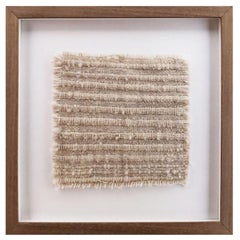Stratum Textile White Wall Piece
Recent Sales
2010s Arts and Crafts Decorative Art
Wool
A Close Look at arts-and-crafts Furniture
Emerging in reaction to industrialization and mass production, the Arts and Crafts movement celebrated handcrafted design as a part of daily life. The history of Arts and Crafts furniture has roots in 1860s England with an emphasis on natural motifs and simple flourishes like mosaics and carvings. This work is characterized by plain construction that showcases the hand of the artisan.
The earliest American Arts and Crafts furniture dates back to the start of the 20th century. Designers working in this style in the United States initially looked to ideas put forth by The Craftsman, a magazine published by Wisconsin native Gustav Stickley, a furniture maker and founder of the Craftsman style. Stickley’s furniture was practical and largely free of ornament. His Craftsman style drew on French Art Nouveau as well as the work he encountered on his travels in England. There, the leading designers of the Arts and Crafts movement included William Morris, who revived historical techniques such as embroidery and printed fabrics in his furnishings, and Charles Voysey, whose minimal approach was in contrast to the ornamentation favored in the Victorian era.
American Arts and Crafts work would come to involve a range of influences unified by an elevation of traditional craftsmanship. The furniture was often built from sturdy woods like oak and mahogany while featuring details such as inlaid metal, tooled leather and ceramic tiles. The style in the United States was led by Stickley, whose clean-lined chairs and benches showcased the grain of the wood, and furniture maker Charles Rohlfs, who was informed by international influences like East Asian and French Art Nouveau design.
Hubs in America included several utopian communities such as Rose Valley in Pennsylvania and the Byrdcliffe Arts and Crafts Colony in New York, where craftspeople made furniture that prioritized function over any decoration. Their work would influence designers and architects including Frank Lloyd Wright, who built some of the most elegant and iconic structures in the United States and likewise embraced a thoughtful use of materials in his furniture.
Find antique Arts and Crafts chairs, tables, cabinets and other authentic period furniture on 1stDibs.
Finding the Right decorative-art for You
Antique, new and vintage decorative art is crucial to personalizing your interior.
Bringing art into your home will help you create a warm and welcoming atmosphere, whether you are expecting to regularly host guests for cocktails in your living room or you are inclined to soak up some “me time” on weekends by curling up with a book in your library. After all, a room isn’t quite complete until you hang some art on the walls.
Choosing a piece of art for your interior is a matter of finding something that resonates with you. You should also consider what will work with your current decor. Keep in mind that a wide range of objects counts as decorative art — antique and vintage prints, paintings, wall-mounted sculptures and more. There is so much to choose from! And art can feel as deeply personal with the vintage posters that promoted your favorite classic films as it can with framed photographs of your loved ones.
Decorative art can set the mood for a room and will typically make for great conversation. When you find wall decor and decorations that speak to you, why not introduce them into your space? It will give you and your guests the opportunity to meaningfully engage with the art every time you see it. You can play with different styles, eras and colors. Mix and match pieces to integrate a refreshing pop of color or create a theme by dedicating a room to a color palette or certain time period. A great way to tie your layout together is to choose wall art that complements your decor and color scheme.
Folk art is an interesting category for its wide range of works across various media and the array of textures it can offer. Paper art is another versatile option because it will be easy to find a home for portraits, collages, drawings and other works in your space. With decorative paper art, you can also get creative with how you arrange your wall art. There are plenty of options that include hanging the works salon-style.
On 1stDibs, find a constantly growing collection of antique and vintage decorative art today.
